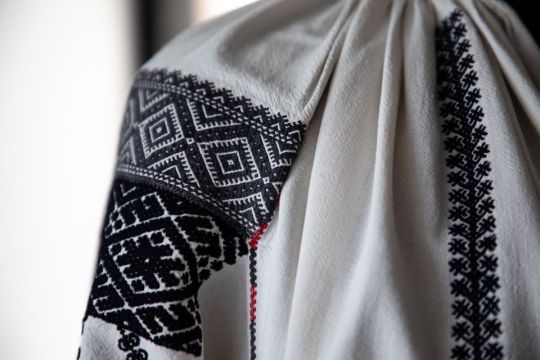Text

Winter Queen’s Flowers. Vintage Polish postcard with artwork by Zofia Plewińska Smidowiczowa, 1934.
6K notes
·
View notes
Text
Witches come in ALL shapes, sizes, genders, races.
Witches are NOT just "pretty" skinny white women.
STOP excluding other genders.
STOP excluding other races.
STOP excluding other sizes.

149 notes
·
View notes
Photo






Here’s a link:
https://4ocean.com/pages/octopus
There’s different colors representing different sea creatures ❤️🌊

Just a little reminder that the US Military is the world’s biggest polluter. The fight against ecological disaster must include fighting the war machine!
178K notes
·
View notes
Text
What happened yesterday in Warsaw? (7.08.20)
Yesterday, an attempt was made to arrest for 2 months an activist Margot (a non-binary person - from Stop Bzdurom) for damage to a van that preaches homophobic slogans (such as "homosexuals are pedophiles") and for damage to the health of the person from the foundation that finances these vans - (these vans often drive around Poland in police custody). When they came to get her, she was in the headquarters of KPH (Kampania Przeciw Homofobii - Campaign Against Homophobia). On the Internet, I read how they called to appear there and disturb the police. The police could not get to Margot thanks to people who came and other activists.
Eventually Margot went out to voluntarily surrender herself to the police, but was not arrested. The police left her...
Margot and the rest of them went to the Krakowskie Przedmieście district, where a rainbow flag was hung on the Nicolaus Copernicus monument again. Then Margot was raided in an unmarked police car. Even more people gathered in the square and sat around the car so that it could not leave. Police was agressive.
There were no warnings before the police started using force. It was brutal. The left-wing MPs were on the spot and tried how they could defend those who were treated worst.


(Jakub Kaminski - East News/ Przemysław Stefaniak)

Paweł H. Głogowski/REPORTER
Everything lasted many hours and about 50 people were detained/arrested.
The MP testifies that she heard the cops talking to each other to arrest 3 people at random.
„An escalation in police violence I haven't seen in a long time.
We were blocking the car with Margot. The police crashed the crowd. Then the car tried to drive away, but the crowd kept blocking it... Another person who threw himself on the car to stop the political police from taking the activist. This is our rainbow civil disobedience. I don't have a word for what happened. Tears come into my own eyes. There are many detainees at several commands and a huge team of attorneys who help. There are also MPs from the opposition.”
- Bart Staszewski
"Solidarity is our weapon."

Foto. Przemysław Stefaniak
Please share this.
5K notes
·
View notes
Text
I know Tumblr is mostly US-centric but please, follow tags like "Poland", "StopBzdurom" (name of a collective, translated to Stop Bullshit), "Margot/Margot Szutowicz/Małgorzata Szutowicz"
(I will edit if there is anything more, basically check the tags I used).
Margot is a non-binary she/her pronouns using activist who decorated statue of Jesus Christ and other statues with Pride flag. She also got in a quarrel with a driver of a truck with anti-LGBT banner (which (mis)informed that LGBT people are pedophiles. That's why she was angry). Yesterday police came for her, to arrest her for those acts (100% against the law, tho) but people blocked them. The crowd went on a stroll to said Christ statue and once again police arrested Margot, locked her up in unmarked car. Police also beat the protestors and arrested random people. Few polish envoys were there and tried to help all the people they could because police was so brutal they even choked and stomped on people's heads.
Spread the news everywhere.
Don't make us suffer in silence.
We have had enough of homophobic government, president and prime minister calling us, LGBT+, an ideology, not-people, and caring more about the statues than about citizens.
6K notes
·
View notes
Text
Intro to Spirit Work

Throughout history those who practice magic have had a close connection to the spirit world, from fairy doctors who were said to learn their craft from the fae, to ceremonial magicians invoking angels and demons, to witches working with familiar spirits. To practice magic is to open yourself to this connection and to become aware of a whole new world of intelligent beings.
In modern Western culture, there’s a lot of fear around working with spirits. There are countless horror stories about malevolent hauntings, seances gone wrong, and violent possessions. It’s easy to see why many new witches are reluctant to work with spirits.
Ironically, in most other times and places, the spirit world was and is accepted as a normal part of life. All over the world, since before recorded history, people have honored their ancestors, left offerings for local land spirits, and built relationships with deities. We’re actually the weirdos for not having a healthy relationship with the spirits around us.
I personally have found working with spirits to be incredibly rewarding, and being aware of the spirits around me adds a lot of depth to my spiritual practice and my witchcraft. As long as you do your research, keep your wits about you, and are polite, you have nothing to fear and everything to gain from working with spirits.
Some Philosophy Terms
Animism: defined by Merriam-Webster as “attribution of conscious life to objects in and phenomena of nature or to inanimate objects.” An animist believes that all things have a spirit, from animals and plants to rocks and even man-made objects. Animism is a big part of many magical practices, especially in folk magic. It’s also a part of several modern religions, including Shinto and Anito. I personally am an animist, and my magic includes connecting with the spirits of the plants, crystals, and objects I work with.
Pantheism: defined by Merriam-Webster as “a doctrine that equates God with the forces and laws of the universe.” A pantheist believes that the physical world is the Divine. Whereas an animist believes that all things have their own spirit, a pantheist believes that the entire world shares a single, divine spirit. Many Wiccans are pantheists, and in some cases pantheism can coexist with animism (all things are both individual spirits and part of the divine whole).
Panentheism: defined by Merriam-Webster as “the doctrine that God includes the world as a part though not the whole of his being.” A panentheist believes that the world is a part of the divine, but that there is also a part of the divine that exists beyond the physical world. Some Christian groups are panentheists. Another example of panentheism is ancient Egyptian religion, where natural objects like the sky and the sun were seen as the bodies (but not the souls) of the gods.
Which of these philosophies you resonate with will shape how you interact with spirits and the spirit world.

Types of Spirits
This is not by any means an exhaustive list, but here are some of the types of spirits witches commonly encounter or work with:
Ancestors: deceased human spirits, especially those with a familial link to you. Ancestor veneration is a huge part of some magic systems, as well as many religions. Some witches ask their ancestors for help in every single spell or ritual, while others honor their ancestors on certain days, like on Samhain or on a deceased loved one’s birthday. Honoring the ancestors is a good place to start with spirit work because they already have a connection to you and are more likely to be willing to help you. However, working with ancestors can be difficult if you don’t know your family’s history or if you don’t feel close to your family. As author Aaron Oberon says, “Sometimes ancestor work is undoing the blocks our ancestors have built.”
To begin connecting with your ancestors, start by researching your family history. Ask your living relatives about their parents and grandparents. Try your hand at genealogy research and see how far back you can trace your family. If you feel called to do so, you can create a special altar to honor your ancestors. Light candles and leave out offerings of food that your ancestors enjoyed while they were alive.
Land Spirits: spirits that embody and are connected to a natural object or landmark. There are many, many types of land spirits, from individual tree and plant spirits to the spirits of great mountains and rivers. Some land spirits are even worshiped as gods – like Hapi, the Egyptian god of the Nile. Some modern witches even choose to recognize cryptids like Mothman or the Jersey Devil as land spirits! Working with your local land spirits can help you develop a deeper connection to your environment and can make your magic feel more localized and personal.
To begin connecting with land spirits, start by learning about the biology and folklore of your local area. Offerings for land spirits are usually left outside, so be sure to offer things that won’t harm local wildlife. Wild bird seed, fresh fruit, and unsalted peanuts are a few examples of safe offerings.
Spirits of Place: spirits tied to a specific building or location. Unlike land spirits, these beings aren’t always connected to a natural feature. Houses and other buildings can have their own spirits that embody the energy of that place. In Germanic folklore, these spirits are called house wights or husvaettir, and in English folklore they’re called brownies. For people who grew up in non-animist cultures, it can feel strange to leave offerings for the spirit of a man-made building, but there’s a long history of these types of spirits being honored all over the world. I personally see house wights as being similar to land spirits.
If you want to begin connecting with the spirits of your home, start by greeting them by name and leaving out an offering for them. Establishing a relationship with the spirits of your living space can help you create a more harmonious and productive home. Traditional offerings for house wights include dishes of cream, grain-based porridge (like oatmeal or grits), and clean water.
Animal Spirits: the spirit of a specific animal, the archetypal Spirit (with a capital “S”) of an entire species of animal, or an individual spirit that appears as an animal. The concept of animal spirits that act as protectors and guides is found in many cultures, especially those with shamanic traditions. In Norse mythology, fylgjur were protector spirits who often appeared as animals. In British Traditional Witchcraft, witches work with familiar spirits that often take on animal forms. It’s worth noting that the terms “spirit animal” and “totem animal” come from Native American spiritual traditions and should not be used by people who don’t belong to those cultures. The concept of animal guides exists in other cultures, so there’s no reason to appropriate indigenous words and ideas. In my experience, animal spirits are often friendly and easy to connect with, so this is a good place to start for witches who are new to spirit work.
If you’d like to work with animal spirits, you can begin by connecting to the animals that are local to your area. You may feel called to bring a part of the animal you’re connecting with into your sacred space – for example, I keep crow feathers on my altar. Offerings depend on the type of animal spirit you’re connecting to – some require only fresh water, while some traditions state that familiars should be fed with blood (not human). Use your intuition to choose what works for you.
Fairies: fairies are a specific kind of land spirit, and most fairy lore is based on mythology and folklore from the British Isles. Fairies have a reputation in modern pop culture as being sweet, friendly creatures – some authors even compare them to angels! However, I think it’s important to remember that historically, fairies were known for being mischievous and sometimes dangerous. In folklore, fairies are less Tinkerbell and more Spiderwick Chronicles. As author Morgan Daimler says, “They can be cruel and vicious, or generous and kind. Some of them are helpful. Some are indifferent. And some of them think we make a very tasty meal indeed.” For this reason, fairies should be approached with caution.
If you want to honor the fairies in your practice, I recommend checking out Morgan Daimler’s books – they have several on this subject that are both easy to read and well-researched. There are a lot of rules for working with fairies, such as not telling them your full name and not saying “thank you” to a fairy, so this is one type of spirit that you should definitely research before beginning to work with them.
Angels: divine messengers; spirits of love and light that come from the Divine and have no physical form. Strictly speaking, “angel” refers to a messenger of the Abrahamic God, but there are other spirits from other religious traditions that fill a similar role. Angels and similar spirits embody divine love, and as such they are both incredibly powerful and incredibly supportive. Because of their loving nature, working with angels is a good place to start spirit work. Some witches who have had negative experiences with Christianity, Judaism, or Islam may feel uncomfortable working with angels. I have personally found that angels don’t really care how you identify in terms of religion, and have had good experiences with Christian angels even though I identify as pagan. However, your experiences may be different, so please don’t do anything that makes you uncomfortable!
There are a lot of bad resources floating around the Internet when it comes to angels. If you’re interested in working with them, I recommend Chantel Lysette’s books Azrael Loves Chocolate and The Angel Code. There’s also a YouTube channel called Ask Angels with Melanie Beckler – I don’t agree with 100% of her ideas, but it’s a decent free resource. Offerings to angels are typically non-physical, like the light from a candle or the smoke from incense.
Demons: spirits of mischief, strife, and/or evil with no physical form. In Western culture, we associate the word “demon” with Christianity, but demons appear in many other religions, including Hinduism and Kemetic paganism. I personally define “demon” as a spirit who: 1.) is not and never was human, and 2.) is antagonistic towards humans. Most witches only deal with demons when they’re trying to get rid of one. However, there are some magic traditions, such as Goetic Magic, that call on demons in magical rituals. Let me just say this: in my experience, there are very few reasons why someone would want to work with a demon, and doing so is as dangerous for the person doing the summoning as it is for the intended victim. I definitely recommend that new witches stay away from these spirits. (But it should be noted that demons are not the same thing as dark deities!)
If you need to get rid of a demon, sulfur is used in American traditions to banish them. (It may also banish helpful spirits, so keep that in mind.) Blessed water is used to repel demons in several cultures. You can also call on an angel or deity for protection.
Deities: powerful, divine spirits who are worshiped as gods. Deities vary a lot from culture to culture, and each deity has their own personality, moral code, and mannerisms. I have found working with deities to be very fulfilling, as deities allow us to put a human face on the Divine. It’s much easier to form a relationship with, say, Odin than it is with an abstract divine force, at least in my experience. Aside from spiritually fulfilling relationships, deities can also be powerful allies in magic. It’s worth noting that very few deities are 100% good or 100% bad – they’re more nuanced than that. Just like anyone else, deities have strengths and weaknesses. (Yes, even the Abrahamic God. Read the Old Testament sometime and tell me God doesn’t have flaws.)
If you are interested in working with deities, start by doing research into the pantheons you feel drawn to. Were you obsessed with Greek mythology as a kid? (Or Norse? Or Egyptian? Or any other culture?) Read up on it! Find out how those deities were worshiped historically, and use that as a starting point for building your own practice. Offerings for deities vary from culture to culture, but I’ve found that fresh, clean water seems to be pretty much universally accepted.
This post ended up just being a whole lot of vocab, but I wanted to get some definitions straight before I start writing about how to connect with the spirit world. In my next post, I’ll talk about how to introduce yourself to different types of spirits and etiquette for maintaining a healthy relationship!
Resources:
Southern Cunning: Folkloric Witchcraft in the American South by Aaron Oberon
A Practical Heathen’s Guide to Asatru by Patricia M. Lafayllve
Where the Hawthorn Grows by Morgan Daimler
Wicca: A Guide for the Solitary Practitioner by Scott Cunningham
Temple of the Cosmos by Jeremy Naydler
Azrael Loves Chocolate, Michael’s A Jock: An Insider’s Guide to What Your Angels Are Really Like by Chantel Lysette
6K notes
·
View notes
Text


Sure would be a shame if this got spread around and he lost his job 💅🏽
133K notes
·
View notes
Photo







Сорочки Східного Поділля (Вінницька область)
Shirts of the East Podillya (Vinnytsia region), Ukraine
2K notes
·
View notes
Photo

May the 10 of Pentacles bless your account with more money than you can spend. 💵✨
878K notes
·
View notes
Photo

This is money cat. He only appears every 1,383,986,917,198,001 posts. If you repost this in 30 seconds he will bring u good wealth and fortune.
627K notes
·
View notes
Text
Reblog or your mom will die in 928 seconds.
I love my mom.

I am risking nothing

I AM SORRY FOLLOWERS, I LOVE MY MOMMY
Will not risk.

sorry followers :(
5M notes
·
View notes
Text
Save The Date : 2020
The 13 Full Moons of 2020
🌑🌒🌓🌔🌕🌖🌗🌘🌑
🐺 Friday, January, 10th
❄️ Sunday, February, 9th
🐛 Monday, March, 9th
💗 Wednesday, April, 8th
🌸 Thursday, May, 7th
🍓 Friday, June, 5th
🌩 Sunday, July, 5th
🐠 Monday, August, 3rd
🌽 Wednesday, September, 2nd
🏹 Friday, October, 2nd
💙 Saturday, October, 31st
🐿 Monday, November, 30th
🥶 Wednesday, December, 30th
Retrograde Planetary Movements
Uranus Retro in ♉️ : Aug, 12 (2019) – Jan, 1st
Mercury Retro in ♊️+♒️ : Feb, 17th – Mar 10th
Pluto Retro in ♑️ : April, 25th – Oct, 4th
Saturn Retro in ♑️+♒️ : May, 11th – Sept, 29th
Venus Retro in ♊️ : May, 13th – June 25th
Jupiter Retro in ♑️ : May, 14th – Sept, 13th
Mercury Retro in ♋️ : June, 18th – July, 12th
Neptune Retro in ♓️ : June, 23rd – Nov, 23rd
Uranus Retro in ♉️ : Aug, 15th – Jan, 1st (2021)
Mars Retro in ♈️ : Sept, 9th – Nov, 14th
Mercury Retro in ♏️+♎️ : Oct, 14th – Nov, 3rd
Celestial Signs
♑️ Capricorn : Dec, 22nd – Jan, 19th
♒️ Aquarius : Jan, 20th – Feb, 18th
♓️ Pisces : Feb, 19th – Mar, 20th
♈️ Aries : Mar, 21st – Apr, 19th
♉️ Taurus : Apr, 20th – May, 20th
♊️ Gemini : May, 21st – Jun, 20th
♋️ Cancer : Jun, 21st – Jul, 22nd
♌️ Leo : Jul, 23rd – Aug, 22nd
♍️ Virgo : Aug, 23rd – Sept, 22nd
♎️ Libra : Sept, 23rd – Oct, 22nd
♏️ Scorpio : Oct, 23rd – Nov, 21st
♐️ Sagittarius : Nov, 22nd – Dec, 21st
Sabbat Festivals (Northern Hemisphere)
🕯 Imbolc – Candlemas : February, 2nd
🌺 Ostara – Vernal Equinox : March, 21st
🔥 Beltane – Mid Spring : May, 1st
☀️ Litha – Summer Solstice : June, 21st
🌾 Lammas – Harvest : August, 1st
🍁 Mabon – Autumnal Equinox : Sept, 23rd
🎃 Samhain – All Hallows’ Eve : Oct, 31st
❄️ Yule – Winter Solstice : December 21st
Sabbat Festivals (Southern Hemisphere)
🌾 Lammas – Harvest : February, 2nd
🍁 Mabon – Autumnal Equinox : Mar, 21st
🎃 Samhain – Witches’ New Year : May, 1st
❄️ Yule – Winter Solstice : June, 21st
🕯 Imbolc – Candlemas : August, 1st
🌺 Ostara – Vernal Equinox : Sept, 23rd
🔥 Beltane – Mid Spring : October, 31st
☀️ Litha – Summer Solstice : Dec, 21st
19K notes
·
View notes
Text
Ancient Romans buried curse tablets the size of credit cards, called defixiones, in graves and bodies of water, in the hope of bringing suffering on the unlucky soul of their choosing. These curse tablets are so uniform that historians assume that there was a cottage industry of scribes or magicians churning them out.
Whenever you want to make fun of crystal moms or teens in their Wicca phase, just remember that we’ve been reducing magic to cheap mass-produced tchotchkes for actual millennia.
27K notes
·
View notes












